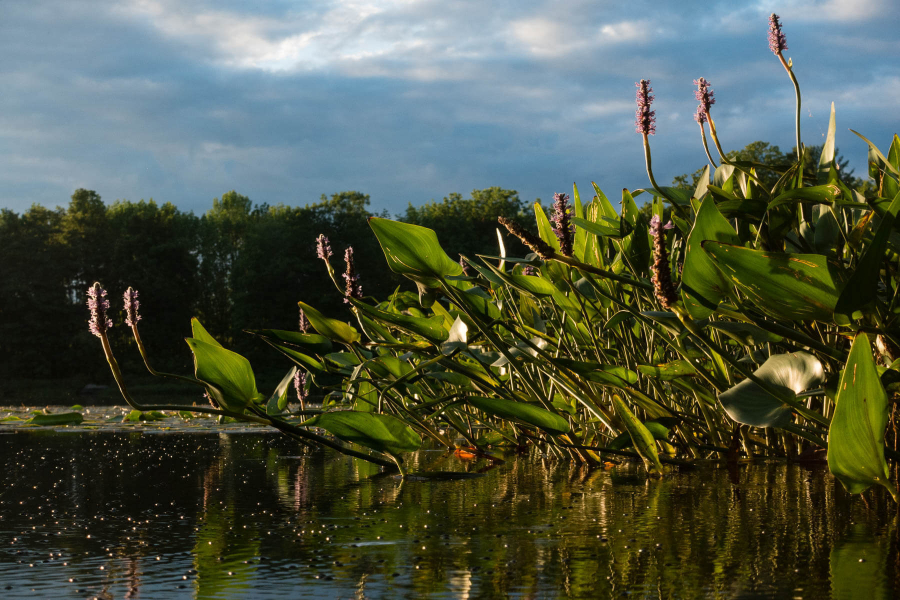Surprising perks of the pickerelweed

Pickerelweed (Pontederia cordata) is a dazzling perennial plant found in freshwater ponds, lakes and tidal wetlands throughout the Chesapeake Bay. The aquatic plant has broad, heart-shaped leaves and vibrant stalks of violet-blue flowers, which produce a sweet nectar that attracts bees, butterflies and other pollinators. It takes its name from the pickerel, or the northern pike—a freshwater gamefish that inhabitants similar environments to the pickerelweed.
Pickerelweed plays an important role in protecting the Bay’s wetland habitat. It has a dense, mat-like root system that holds sediment in place, therefore preventing erosion along unstable shorelines. Pickerelweed is a hardy plant and can withstand heavy flooding, making it an ideal addition to wetland regions throughout the Bay.
Wetlands are critical in supporting the healthy waters and diverse wildlife of the Bay region. They act like a buffer between land and water, soaking up storm surges and trapping polluted runoff. Plants such as pickerelweed go a long way in conserving this valuable resource by minimizing wetland damage from shoreline development and rising sea levels.
Pickerelweed is also an asset to the Bay’s wetland wildlife. The pickerelweed’s fan-like leaves and densely clustered stems provide cover for a variety of wetland fish, birds, insects and small mammals. Ducks and rodents eat the plant’s fruits, while animals such as deer, geese and carp snack on its leaves, roots and stems.
Pickerelweed can also make a tasty snack for humans. It produces nutritious, flavorful seeds that you can mix into a bowl of granola or even roast in the oven. The plant’s leaves are also edible and can be eaten raw in salads, or else boiled and served in melted butter.
Pickerelweed is sometimes confused with arrow arum, a similar looking plant that grows in wetland environments. You can distinguish arrow arum from pickerelweed by its arrowhead-shaped leaves and white flowers.
Whether it’s protecting our wetlands, beautifying our waterways or adding some flavor to our plates, pickerelweed is an invaluable contributor to life in the Bay watershed.

Comments
Does anyone know if Pikeral weed will Do well in the middle of invasive grasses or overtake them?
Much of my lower property is marshland. I am always looking for native plant/shrub/ trees to plant as I get rid of invasives
Is it legal to buy and plant pickerelweed on the shoreline at my home on Stoney Creek? We have some native vegetation, but over the last few years, we have had quite the die-off of native underwater grass/weeds. Since we have pickerel in our creek, though about planting some pickerelweed in certain areas to help with vegetation growth.
Great question, Michael. While pickerelweed provides a lot of critical ecosystem services for our wetlands, unfortunately, it does not directly help prevent water chestnut from growing in an area. Pickerelweed grows along the edges of wetlands where it can get enough sunlight and is an excellent choice for shoreline plantings as a food source for wildlife (pollinators, waterfowl, marsh mammals) and as a method to slow down erosion. Water chestnut seeds accumulate in the river/creek bottom and grow up to form a floating rosette on the surface of the water, which then spreads and multiplies to form a mat across the water. One acre of water chestnut can become 100 acres in 1 year because of how many seeds each plant is capable of producing. These seeds remain viable in the mud for up to 12 years, which means that our eradication efforts are critical every single year if we ever want to truly get rid of this invasive species. Basically, pickerelweed won't grow across the water surface to compete with water chestnut.
Can this be planted in such a way as to keep the dreaded water chestnut from taking hold in tributaries like the Sassafras? It sounds like if planted it could take root on the shore line and keep the water chestnut from taking hold and spreading like it does
Thank you!
Your comment has been received. Before it can be published, the comment will be reviewed by our team to ensure it adheres with our rules of engagement.
Back to recent stories